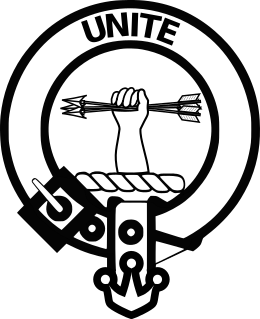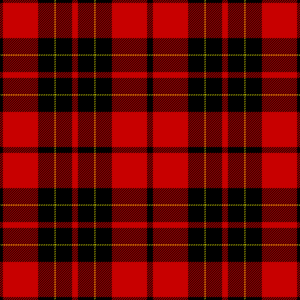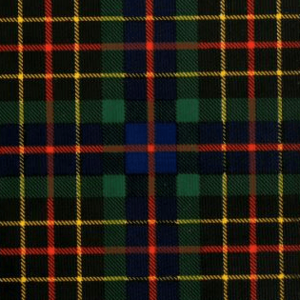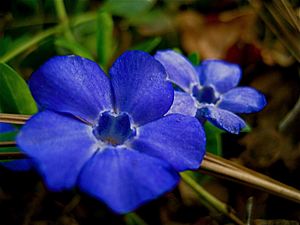Clan Brodie facts for kids
Quick facts for kids Clan Brodie |
|
|---|---|
| Brothaigh | |

Crest: A right hand holding a bunch of arrows all Proper
|
|
| Motto | Unite |
| Profile | |
| District | Moray |
| Founder | uncertain |
| Plant badge | Periwinkle |
| Chief | |
 |
|
| Alexander Brodie of Brodie | |
| The 27th Chief of Clan Brodie | |
| Historic seat | Brodie Castle |
Clan Brodie is a Scottish clan with a long and interesting history. Their exact beginnings are a bit of a mystery. The first known Brodie leaders were called the Thanes of Brodie and Dyke in Morayshire, a region in Scotland. The Brodies were involved in many clan battles. During a big civil war in the 1600s, they strongly supported the Covenanters, a group who wanted to protect their religious beliefs. Later, they avoided joining the Jacobite uprisings, which were attempts to bring back the old royal family. The chief's family became very successful in colonial India during the time of the British Empire.
Contents
What Does the Name Brodie Mean?

The name Brodie has been spelled in many ways over time, like Brochy, Brothy, or Brode. Because of this, and because the clan's exact origins are unclear, no one is completely sure what the name means.
Here are some ideas about what "Brodie" might mean:
- In Scottish Gaelic, it could mean "a little ridge," "a brow," or "a cliff."
- It might come from an old Irish word broth, meaning "ditch" or "mire" (a muddy place).
- Another Gaelic idea is brothach, meaning "muddy place."
- It could also be from the Gaelic word Brodha, meaning "a point," "a spot," or "a flat piece of land."
- Some think it's from Norman origins. A French book about noble families mentions a 13th-century knight named Guy de Brothie.
- It might even come from the Pictish name Brude or Bridei, like the names of some Pictish Kings.
Clan Brodie's History
The Mysterious Start of the Clan


The beginnings of Clan Brodie are quite mysterious. Many of the old Brodie records were lost when Lewis Gordon, 3rd Marquess of Huntly attacked and burned Brodie Castle in 1645. We know that the Brodies have always been around since records began. This suggests they are a very old clan, possibly from Pictish times. The Picts were an ancient people who lived in Scotland. Historian Dr. Ian Grimble thought the Brodies were an important Pictish family. He even suggested a possible link between the Brodies and the male line of the Pictish Kings.
Early Days of the Clan
The Brodie lands are located between Morayshire and Nairnshire. This area is now on the border of the Scottish Highlands and Moray. In the time of the Picts, this was a central part of the Kingdom of Moravia. Early records show that the Brodie lands were ruled by a leader called a Tòiseach, who later became known as a Thane. Some of the Brodie lands were originally "Temple Lands," owned by the Knights Templar. It's not clear if the Brodies got their name from the land, or if the land was named after the clan.
After the early Tòiseachs, whose names are lost, we find a record of MacBeth, Thane of Dyke, in 1262. Later, in 1311, a Latin record mentions Michael, filius Malconi, Thanus de Brothie et Dyke. It's not certain if MacBeth was from the same family line as Michael. However, the Brodie Chiefs say they are descended from Michael's father, Malcome, who they consider the First Chief and Thane of Brodie.
Michael Brodie of Brodie received an important document from Robert the Bruce, confirming his ownership of the Brodie lands. This document stated that Brodie held his lands by right of succession from his ancestors. This suggests the Brodie chiefs might have come from the royal Pictish family of Brude. There is a lot of evidence of Pictish settlements around Brodie, making this a likely explanation.
Clan Battles in the 1400s and 1500s
Johne of Brode of that Ilk, the 7th chief of Clan Brodie, helped Clan Mackenzie win a battle against Clan MacDonald in 1466. He fought bravely and helped his friends while causing great loss to his enemies. This created a strong friendship between Clan Mackenzie and Clan Brodie that lasted for generations.
Clan Brodie also joined the royal army in 1481. This army was led by the Earl of Atholl against the rebel son of the Lord of the Isles, Aonghas Óg. However, Aonghas Óg defeated them, and 517 of the royal army were killed.
Thomame Brodye de iodem, the 11th chief, bravely died defending Scotland against an English invasion at the Battle of Pinkie Cleugh.
In 1550, Alexander "the rebel" Brodie of that Ilk, the 12th chief, along with his clansmen and help from the Dunbars and Hays, attacked Clan Cumming at Altyre. He wanted to kill their chief, Alexander Cumming of Altyre. As a result, he was declared a rebel for not appearing in court. But he was pardoned the next year.
In 1562, the same Alexander "the rebel" joined Clan Gordon and George Gordon, 4th Earl of Huntly in their rebellion against Mary, Queen of Scots. They were defeated at the Battle of Corrichie. Huntley died, and Brodie escaped. He was again declared a rebel and lost his lands. For four years, he was an outlaw. But in 1566, the Queen forgave Clan Gordon, and Alexander Brodie was included in the royal pardon. He got his lands back.
The 1600s and the Civil War

In 1645, Lord Lewis Gordon burned down Brodie Castle. This castle was a Z-shaped tower house built in the mid-1500s. The building you see today is a restored version of that castle. The tower itself might be as old as 1430, and the newest parts were added between 1820 and 1830. Near the castle, on Downie Hillock, you can find the remains of an old Iron Age fort.
Alexander "the good" Lord Brodie of Brodie, the 15th chief, was a covenanter during the Wars of the Three Kingdoms. He was a very strong Presbyterian, which was a type of Christian faith. His strong beliefs led him to be involved in the destruction of some parts of Elgin Cathedral. He also served as a judge in trials where people were accused of witchcraft. He was responsible for finding and dealing with Catholic priests and for setting up churches. Lord Brodie was also part of committees for war, land, protecting religion, and taxes. He was chosen as the Commissary-General for the Army. Clan Brodie was part of the Covenanter army that lost the Battle of Auldearn to Montrose in 1645. After the Covenanters were defeated, Clan Gordon attacked Brodie Castle and surrounded Lethen House. The Brodies of Lethen successfully defended their home for twelve weeks.
Lord Brodie of Brodie traveled to The Hague twice to ask King Charles II of Scotland to return from exile. He went in 1649 and again in 1650, successfully bringing the King back. Oliver Cromwell, who was a powerful leader at the time, wanted Lord Brodie to join his government. Lord Brodie felt tempted but resisted Cromwell's offer to discuss Scotland and England joining together. He wrote in his diary that this was his greatest challenge. In 1650, some royalists tried to capture Lord Brodie, but they failed. He kept a diary that showed he was a thoughtful and religious person, always trying to do what he believed was right.
Alexander Brodie of Lethen went south with a group of men. He led a troop with some success at the difficult Battle of Dunbar (1650).
The 1700s and Jacobite Uprisings
During the Jacobite rising of 1715, James Brodie of Brodie, the 18th chief, refused to give his horse and weapons to Lord Huntley. Lord Huntley threatened to destroy Brodie's home, burn his tenants' crops, and harm his people if he didn't obey. But Clan Brodie kept resisting, holding strong in the rebuilt Brodie Castle. Lord Huntley couldn't get enough cannons or gunpowder to attack, so he had to give up his threats.
During the Jacobite rising of 1745, the Brodie chief was Alexander Brodie of that Ilk, the 19th chief. He was also the Lord Lyon King of Arms, a very important official in Scotland.
Naval Captain David Brodie, from the Brodies of Muiresk family, was a skilled naval officer. He commanded several ships, including the Terror and the Merlin. Later, he became captain of HMS Canterbury and HMS Strafford. He was known for capturing 21 French and Spanish enemy ships.
By 1774, the Brodie estate was having money problems and had to be sold. James Brodie of Brodie, the 21st Chief, was married to Lady Margaret Duff. Her father, William Duff, 1st Earl of Fife, helped out. He bought the estate and gave half of it back to The Brodie.
The 1800s and India Connections
James Brodie of Brodie's younger brother, Alexander, traveled to India to make his fortune. He returned from Madras (now Chennai) a very wealthy man. He bought large estates in Elgin, Kincardineshire, and The Burn. He married a daughter of James Wemyss of Wemyss and had one daughter, Elizabeth. Elizabeth Brodie inherited a lot of wealth. In 1813, she married George Gordon, Marquess of Huntly. When his father died in 1827, he became The 5th Duke of Gordon. George and Elizabeth did not have children. When he died in 1836, the line of the Dukes of Gordon ended. Elizabeth became the last Duchess of Gordon. After her husband's death, the Duchess joined the Free Church of Scotland and was a very generous supporter. She was "much respected and loved" by the people and lived a "remarkably unaffected, charitable, and Christian life."
James Brodie of Brodie's son, also named James Brodie, went to India and worked for the East India Company. He built a grand house in Madras on the banks of the river Adyar and named it Brodie Castle. This building still stands today and is now the College of Carnatic Music. Sadly, James (the younger) died in India in a boating accident on the Adyar River in 1801 or 1802.
When the Duchess of Gordon died in 1864, the Brodies of Brodie inherited much of the Gordon family's movable property.
Recent Clan History
In 1972, a rare old church document was found in Brodie Castle. It is now kept in the British Museum. This document is thought to be from around 1000 CE and shows connections to Durham.
(Montague) Ninian Alexander Brodie of Brodie, the 25th Chief, who was sometimes a stage actor, passed away in 2003. He had given Brodie Castle to the National Trust in 1978. Because his children were not happy with this decision, no Brodie family members live at the castle anymore. The family part of the castle is now prepared for holiday rentals.
The 26th Chief, Ninian Brodie of Brodie's son, Alastair Ian Ninian, also passed away in 2003 at age 61. He lived in Cambridgeshire and worked in IT. He had distanced himself from his family after his divorce in 1986. His son is the current 27th Chief, Alexander Tristan Duff Brodie of Brodie. The 26th Chief left most of his estate to his second wife, with the 27th Chief receiving a smaller amount.
Clan Traditions and Legends
Tradition says there is a curse on the Brodie Chiefs. The curse states that "no son born within the Castle of Brodie should ever become heir to the property." The story behind this curse is that an early Brodie Chief tricked an old woman into confessing to witchcraft by offering her a new gown. Instead of keeping his promise, he had her tied to a stake and burned.
The "blasted heath" where Macbeth is said to have met the three witches in Shakespeare's play Macbeth, is located on the lands of Brodie. This spot is known locally as Macbeth's Hillock.
Brodie Family Branches
| Brodie of Brodie | Brodie of Spynie | Brodie of Lethen |
|---|---|---|
| Brodie of Mylntoun | Brodie of Mayne | Brodie of Rosthorn |
| Brodie of Idvies | Brodie of Boxford | Cap. David Brodie |
|
Brodie-Wood of Keithick |
Callender-Brodie of Idvies |
Brodie-Innes of Milton Brodie |
The Clan Brodie has many different family branches that have grown over time. These include:
- The Thanes and The Chiefs of Brodie
- Brodies of Spynie
- Brodies of Asleisk
- Brodies of Lethen
- Brodie-Wood of Keithick
- Brodies of Idvies, The baronet of Idvies
- Callender-Brodie of Idvies
- Brodies of Muiresk
- Brodies of Coltfield
- Brodies of Milton
- Brodies of Windy Hills
- Brodies of Maine
- Brodie-Inneses of Milton Brodie
- Brodies of Eastbourne
- Brodies of Fernhill
- Brodies of Boxford, The baronets of Boxford
- Brodies of Caithness
Clan Profile

- Clan chief: The current leader of Clan Brodie is Alexander Tristan Duff Brodie of Brodie. He is the 27th Chief of Clan Brodie and a member of the Standing Council of Scottish Chiefs.
- Clan Crest badge: This badge shows the chief's heraldic crest and motto.
- Chief's motto: Unite.
- Chief's crest: A right hand holding a bunch of arrows.
- Clan Plant Badge: The plant badge of Clan Brodie is the Periwinkle.
See also
- Scottish clan
- Brodie Castle
- Brodie (surname)
Images for kids















